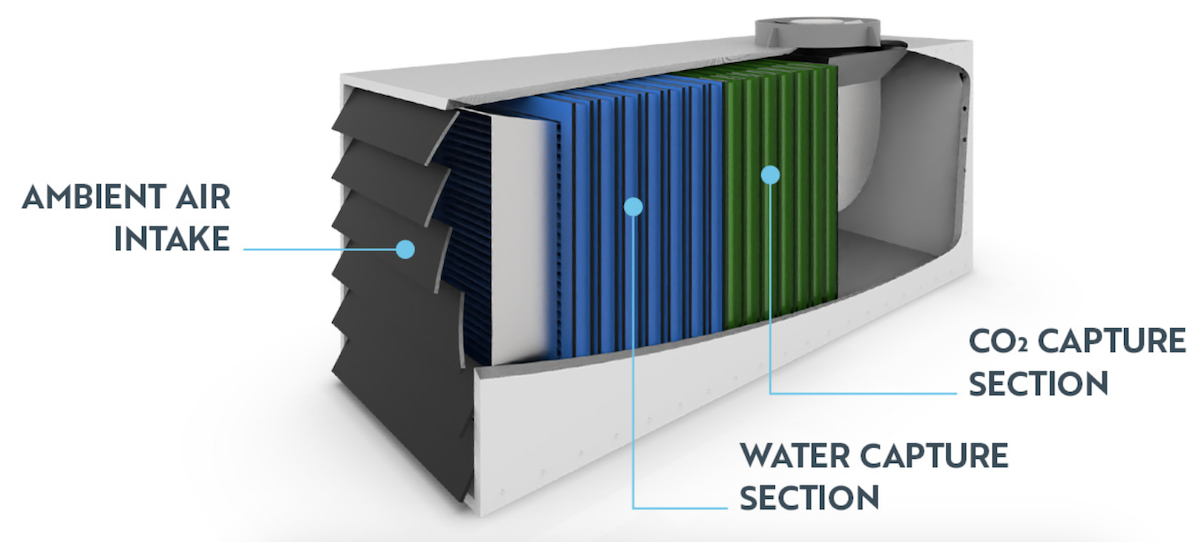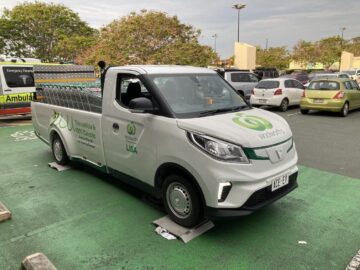
Sign up for daily news updates from CleanTechnica on email. Or follow us on Google News!
In a new twist on the energy-water nexus, the US startup Avnos has just nailed down $36 million in Series A funding to jump its new carbon capture and water recovery system from the pilot stage to market. Some of the usual suspects from the oil and gas industry are lining up behind the venture, but the CleanTechnica ears pricked up when we learned that the US Office of Naval Research initially helped Avnos get its technology in shape to draw the attention of investors, and that makes things interesting.
Direct Air Carbon Capture, Now With Water Capture
Before we get to the Navy, let’s start with the latest news. Earlier this week, Avnos shared an embargoed press release with CleanTechnica detailing the $36 million round of funding for a proprietary carbon capture system it calls HDAC, short for Hybrid Direct Air Capture.
The Series A round was spearheaded by a subsidiary of the US energy firm NextEra Energy Resources, LLC, described by Avnos as “the world’s largest generator of renewable energy from the wind and sun and a world leader in battery storage.”
So far, so good, though Avnos notes that Shell Ventures is also in the mix. For the record, the other series A investors are Safran Corporate Ventures, Envisioning Partners, and Rusheen Capital Management.
Avnos also notes that Shell Ventures and ConocoPhilips propelled earlier funding and strategic agreements, along with JetBlue Ventures and a clean tech accelerator nonprofit called the Grantham Foundation.
SoCalGas Gets Into The Act
Other earlier assistance came from the US Department of Energy. Avnos launched in 2020, deploying technology initially developed at the Energy Department’s Pacific Northwest National Laboratory. By 2021 the company already attracted the attention the Southern California Gas Company (SoCalGas), which agreed to test the system under the terms of a $3.1 million demonstration project.
The company chipped in $650,000 and the Energy Department also lent a hand, with PNNL contributing the design and development of the system components.
To be clear, SoCalGas is not relying on carbon capture systems to do all the heavy lifting towards its carbon neutral goal. The company has assessed that carbon capture has a role to play alongside electrification, hydrogen, and renewable natural gas, depending on how the pieces come together in terms of rapid scaleup and economic feasibility.
“Testing the new carbon capture technology, called Isothermal Water Vapor and CO2 Capture (IWVC), will provide key insight into its efficiency and operating costs, ultimately determining the cost-effectiveness of its deployment at scale,” SoCalGas explained in a press statement.
The demonstration project aimed at capturing 1,000 liters (264 gallons) of water and 80 kilograms (176 pounds) of carbon dioxide per day. That’s just for starters.
“We believe that at scale this technology has the potential to generate approximately 15 million gallons of water a day while removing 1.8 million tons of CO2 from the air each year in a single system,” said Avnos CEO Will Kain in a press statement.
Next-Generation Carbon Capture With Moisture Swing Adsorbents
Some direct air carbon capture systems deploy an adsorbent material to capture water vapor and carbon, similar to the little packets of desiccants found in the boxes of new shoes and other products. Adsorbent materials attract moisture to their surfaces. In contrast, absorbent materials swell up as they ingest liquids, sponges being a typical example.
In terms of the energy-water nexus, the use of adsorbents for direct air carbon capture systems faces two challenges. One is the reliance on water resources to capture the carbon, and the other is the reliance on thermal energy to extract it. Apparently PNNL researchers figured out a way around that.
“High temperature is normally used to regenerate desiccants, which would be far too energy intensive and costly for DAC,” explains Dr. Peter McGrail, Laboratory Fellow at the lab. “IWVC’s desiccants instead are regenerated without any outside heating, which makes it economical to produce water along with the CO2.”
The two-stage process begins with the binding of water vapor and carbon dioxide to the adsorbent. The water is condensed out in the second step, and the carbon dioxide is compressed for destination elsewhere. SoCalGas listed storage as one of the destinations, but they also noted that the CO2 can be used to make fuels and other products, which was a good guess considering the growth of the green hydrogen and electrofuels industry since 2021.
What About The US Navy?
Yes, what about them? CleanTechnica is reaching out to Avnos for some details about the Navy’s early stage contribution to their technology. For now, let’s just note that energy efficient water reclamation is a critical matter for the Navy, so it’s not surprising that the Naval Research Laboratory would express an interest in new cutting edge technologies.
In 2017, the US Naval Research Laboratory contributed funding to a carbon capture study of a rapid swing-moisture carbon dioxide sorbent, along with the National Science Foundation of China. The study was authored by researchers Xiaoyang Shi of Columbia University, Qibin Li of Chongqing University in China, Tao Wang of Zeizhiang University in China, and Klaus S. Lackner of the University of Arizona.
That particular study involved an absorbent, not an adsorbent. The details are available from the journal PLOS ONE under the title, “Kinetic analysis of an anion exchange absorbent for CO2 capture from ambient air.”
Perhaps due to the rapid development of materials science, the preferred term in more recent years seems to be plain old sorbent. In 2020, Klaus Lackner described the principles at work in a proposed “Mechanical Tree” that deploys the moisture swing mechanism to capture carbon at 1,000 times the rate of a natural tree.
“This concept is not surprising to me because I’ve been playing with this stuff for a decade, but the moisture swing concept is still very novel and very different from other ways of loading and unloading a sorbent,” Lackner explained in an article published in 2020.
“We discovered this phenomenon 14 years ago, and for a long time it was a mystery on how it worked. Now it seems pretty obvious,” he added.
In 2021 a team based in China reviewed the carbon capture literature and also settled on moisture swing technology as the most promising pathway towards low cost carbon capture with water reclamation.
“Recently, a novel moisture swing technique was proposed and studied as a new approach for CO2 capture (Wang et al., 2011). The sorbent is an anion exchange resin that carries carbonate ions for CO2 adsorption via moisture swing, based on the mechanism of the water-driven reversible hydrolysis reaction of carbonate ions in a confined nano-environment (e.g., nanopores) (Shi et al., 2016),” the team explained.
“Driving by the evaporation of water, the resin obtains high affinity to CO2 when surroundings are dry, and releases it when wet. This unique mechanism results in a moisture swing sorbent for CO2 adsorption, which showed a low CO2 adsorption heat of ∼32 kJ/mol (Shi et al., 2020a), as the traditional thermal swing process is replaced by water evaporation,” they added.
Circling back around to that Navy funding, a mention of carbon capture with electrofuels production was somewhere in the mix, which makes sense considering the Navy’s interest in producing fuel on-the-go in addition to water recovery. We’ll as Avnos about that, too, so stay tuned for more details.
Follow me @tinamcasey on Bluesky, Threads, Post, and LinkedIn.
Image: A new hybrid direct air carbon capture system from the US startup Avnos cuts costs and produces water, too (courtesy of Avnos).
Have a tip for CleanTechnica? Want to advertise? Want to suggest a guest for our CleanTech Talk podcast? Contact us here.
Latest CleanTechnica TV Video
[embedded content]
I don’t like paywalls. You don’t like paywalls. Who likes paywalls? Here at CleanTechnica, we implemented a limited paywall for a while, but it always felt wrong — and it was always tough to decide what we should put behind there. In theory, your most exclusive and best content goes behind a paywall. But then fewer people read it!! So, we’ve decided to completely nix paywalls here at CleanTechnica. But…
Thank you!
Advertisement
CleanTechnica uses affiliate links. See our policy here.
- SEO Powered Content & PR Distribution. Get Amplified Today.
- PlatoData.Network Vertical Generative Ai. Empower Yourself. Access Here.
- PlatoAiStream. Web3 Intelligence. Knowledge Amplified. Access Here.
- PlatoESG. Carbon, CleanTech, Energy, Environment, Solar, Waste Management. Access Here.
- PlatoHealth. Biotech and Clinical Trials Intelligence. Access Here.
- Source: https://cleantechnica.com/2024/02/06/direct-air-carbon-capture-water-resources-energy-efficient/
- :has
- :is
- :not
- $3
- $UP
- 000
- 1
- 14
- 15%
- 2011
- 2016
- 2017
- 2020
- 2021
- 264
- 36
- 8
- 80
- a
- About
- accelerator
- added
- addition
- Advertise
- Affiliate
- affinity
- ago
- agreed
- agreements
- aimed
- AIR
- AL
- All
- along
- alongside
- already
- also
- always
- Ambient
- an
- analysis
- and
- any
- approach
- approximately
- ARE
- arizona
- around
- article
- AS
- assessed
- Assistance
- At
- attention
- attract
- attracted
- authored
- available
- back
- based
- battery
- battery storage
- BE
- because
- been
- begins
- behind
- being
- believe
- BEST
- binding
- Bit
- bluesky
- boxes
- but
- by
- california
- called
- Calls
- came
- CAN
- capital
- capture
- captures
- Capturing
- carbon
- carbon capture
- carbon dioxide
- ceo
- challenges
- China
- chip
- clean
- cleantech
- Cleantech Talk
- clear
- co2
- Columbia
- come
- Companies
- company
- completely
- components
- concept
- considering
- content
- contrast
- contributed
- contributing
- contribution
- Corporate
- Cost
- costly
- Costs
- courtesy
- critical
- cuts
- cutting
- day
- decade
- decide
- decided
- Department
- Department of Energy
- Depending
- deploy
- deploying
- deployment
- deploys
- described
- Design
- destination
- destinations
- Detailing
- details
- determining
- developed
- Development
- different
- direct
- discovered
- do
- don
- down
- dr
- draw
- dry
- due
- e
- E&T
- each
- Earlier
- Early
- early stage
- Economic
- Edge
- efficient
- electrification
- elsewhere
- embargoed
- embedded
- energy
- energy intensive
- example
- exchange
- Exclusive
- explained
- Explains
- express
- extract
- faces
- far
- feasibility
- fellow
- felt
- fewer
- figured
- Firm
- For
- found
- Foundation
- from
- Fuel
- fuels
- funding
- GAS
- generate
- generator
- get
- gets
- goal
- Goes
- good
- Growth
- guess
- Guest
- hand
- he
- heavy
- heavy lifting
- help
- helped
- here
- High
- How
- HTML
- HTTPS
- Hybrid
- hydrogen
- if
- implemented
- in
- industry
- initially
- insight
- instead
- intensive
- interest
- interesting
- into
- Investors
- involved
- IT
- ITS
- jetBlue
- journal
- jump
- just
- Key
- klaus
- lab
- laboratory
- largest
- latest
- Latest News
- launched
- leader
- learned
- li
- lifting
- like
- likes
- Limited
- lining
- links
- Listed
- literature
- little
- LLC
- loading
- Long
- long time
- Low
- make
- MAKES
- Market
- material
- materials
- Matter
- me
- mechanism
- Media
- mention
- million
- mix
- more
- most
- Mystery
- National
- National Science
- Natural
- Natural Gas
- Need
- Neutral
- New
- news
- nexus
- Nonprofit
- normally
- note
- noted
- Notes
- novel
- now
- obtains
- obvious
- of
- Office
- Oil
- Oil and Gas
- Old
- on
- ONE
- operating
- or
- Other
- our
- out
- outside
- Pacific
- packets
- particular
- pathway
- People
- per
- Peter
- phenomenon
- pieces
- pilot
- Plain
- plato
- Plato Data Intelligence
- PlatoData
- Play
- player
- playing
- podcast
- policy
- Post
- potential
- pounds
- preferred
- press
- Press Release
- pretty
- principles
- PRNewswire
- process
- produce
- produces
- producing
- Production
- Products
- project
- promising
- propelled
- proposed
- proprietary
- provide
- publish
- published
- put
- rapid
- Rate
- reaching
- reaction
- Read
- Reader
- recent
- record
- recovery
- release
- Releases
- reliance
- relying
- removing
- Renewable
- renewable energy
- replaced
- research
- researchers
- Resin
- Resources
- Results
- reversible
- reviewed
- Role
- round
- s
- Said
- Scale
- Science
- Science Foundation
- Second
- see
- seems
- sense
- Series
- Series A
- Series A funding
- series a round
- Settled
- Shape
- shared
- Shell
- Short
- should
- showed
- similar
- since
- single
- So
- some
- somewhere
- Southern
- spearheaded
- Stage
- start
- starters
- startup
- Statement
- stay
- Step
- Still
- storage
- Stories
- Strategic
- studied
- Study
- stuff
- subsidiary
- suggest
- Sun
- support
- surprising
- Swing
- system
- Systems
- T
- Talk
- team
- tech
- technique
- Technologies
- Technology
- term
- terms
- test
- that
- The
- their
- Them
- then
- theory
- There.
- thermal
- they
- things
- this
- this week
- though?
- time
- times
- tip
- Title
- to
- together
- tons
- too
- tough
- towards
- traditional
- tree
- tuned
- tv
- twist
- two
- typical
- Ultimately
- under
- unique
- university
- Updates
- us
- use
- used
- uses
- usual
- Ve
- venture
- Ventures
- very
- via
- Video
- wang
- want
- was
- Water
- Way..
- ways
- we
- week
- What
- when
- which
- while
- WHO
- will
- wind
- with
- without
- Work
- worked
- world
- world’s
- would
- write
- Wrong
- year
- years
- you
- Your
- youtube
- zephyrnet







